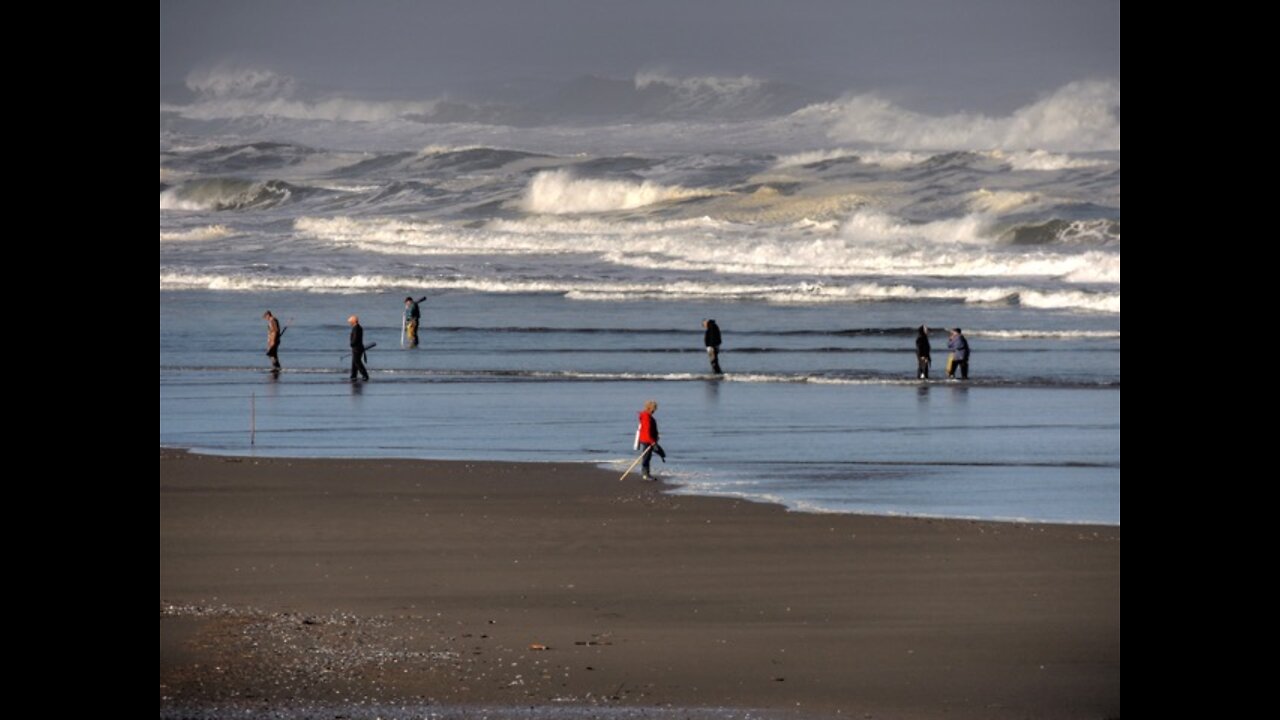Premium Only Content

It looks like a normal sandy beach - but that's definitely not the case 😳
Sandy beaches are a widespread feature of the entire Oregon coast and make up approximately two-thirds of the coastline. Their distribution is interrupted by rocky shores, rocky headlands, river mouths, estuaries, and human constructions. Oregon’s sandy beaches are characterized by CMECS as marine nearshore areas in the intertidal and supratidal zones that are composed of very fine to very coarse sand substrate; they extend in a continuum from the Mean Lower-Low Water line to the areas above the Mean Higher-High Water line that are affected by wave splash and overwash at extreme high tides, but not areas affected only by wind-driven spray. Sandy beaches stretch inland until they are stopped by a continuous line of vegetation, debris, rocks, or other barrier. Everything beyond the reach of the waves and splash zone is considered terrestrial habitat.
PHYSICAL ENVIRONMENT
Oregon’s sandy beaches are high-energy environments that experience significant wave and wind energy. Several million cubic meters of sand are transported to the nearshore area annually by river systems. Seasonal variation in wind and wave energy and currents move substantial amounts of sand onto or off beaches, which results in significant changes in beach character as underlying rock structures (bedrock and/or cobble) are exposed. In some areas, patches of ancient forest where the land dropped during past subduction zone earthquakes may become exposed. Currents and wave energy are other significant factors in moving sands onto or off of beaches at elevations that are frequently immersed; the lateral width of the beach will govern the area over which current and wave energy is dispersed, and hence determines the slope of the beach as sands are deposited or swept away. At higher elevations that are dry and experience infrequent immersion by tides, wind is the predominant factor in distributing sand, and can create windrows and mobile dunes from a few centimeters to several meters tall, while dunes further inland may be several stories high.
The lateral (north-south) extent of sandy beaches is punctuated by rivers or rocky headlands where the transition from sand to volcanic rock can be quite abrupt. Rivers can frequently become “bar-bound” during the summer and early fall months when river flows diminish due to reduced precipitation, and the energy of flowing water is insufficient to maintain an open, flowing channel to the sea. In such cases, the river or stream will flow through the sand in its final stages. Bar-bound rivers are generally freed by fall rains on the Oregon coast that increase river flows and wash sand out of the river mouths to re-establish a channel of flow. Fall rains and the breaking of blocking bars are important in restoring access to fresh-water streams for anadromous fishes.
The supratidal zone and upper range of the intertidal zone are subject to the greatest variation in temperature and moisture and the least physical energy from the ocean. The intertidal zone, particularly its lower reaches, receives much greater physical energy from waves and currents, and also experiences the least variation in temperature.
BIOLOGICAL CHARACTERISTICS
The movement of sand by water and wind energy makes sandy beaches largely unsuitable for rooted and attached organisms. However, between the grains of sand in the intertidal zone is a vast multitude of life too small to see with the naked eye, including diatoms, harpacticoid copepods, amphipods, and algae, among others. Larger invertebrates can be found here as well, including crustaceans, mollusks, and diverse worm taxa. Many of the resident invertebrates burrow in the sand during periods of exposure for protection from desiccation and/or predation, and emerge to forage as tides permit.
Biological communities of the upper intertidal and supratidal zones of sandy beaches are often based on the resources provided by the incoming tides and deposited at the high tide line. Once in the intertidal zone, the detritus is broken down by the mechanical force of waves pounding against the shore and the industry of the many organisms that live and forage there. Organisms of the mid and lower intertidal, particularly the small invertebrates, provide food resources for numerous larger invertebrate, fish, and bird species. Some marine mammals intentionally use this zone to rest, hauling themselves out of the ocean to lay on the sand.
-
 2:38:46
2:38:46
GamerGril
4 hours agoBingo With Doom Gal | Finishing The DLC | Doom Eternal
4411 -
 LIVE
LIVE
MDGgamin
8 hours ago🔴LIVE - Red Dead Redemption 2 - Wake Up Pray Up & Obama Treason? - #RumbleTakeover
78 watching -
 1:07:58
1:07:58
Sarah Westall
2 hours agoThe Discipline of Remote Viewing: Shroud of Turin, Surface of Mars & the Unknown w/ Daz Smith & Team
13.1K3 -
 17:37
17:37
Colion Noir
4 hours agoGavin Newsom Gifted A Gun On Shawn Ryan Podcast, Claims He's Not Anti-Gun
17.3K32 -
 LIVE
LIVE
yellow_1ron
1 hour agoALAN WAKE 2 | SCARY GAME TIME | JOIN!
22 watching -
 LIVE
LIVE
OhHiMark1776
4 hours ago🟢 07-20-25 ||||| Baldur's Gate 3 with the Skwaaa ||||| Baldur's Gate 3 (2023)
60 watching -
 31:37
31:37
The Rad Factory
1 day ago $13.21 earnedTesting $300 Amazon Supercharger: Will It Blow??
43.7K13 -
 22:02
22:02
Mrgunsngear
21 hours ago $11.65 earnedHeckler & Koch Full Size VP9A1 F Review: The Best Striker Fired Duty Handgun?
38.1K20 -
 1:25:18
1:25:18
Jeff Ahern
4 hours ago $7.44 earnedThe Sunday Show with Jeff Ahern
29.1K7 -
 LIVE
LIVE
Spartan
5 hours agoSpartan - Pro Halo Player for OMiT | Scrims vs C9 then ranked
151 watching